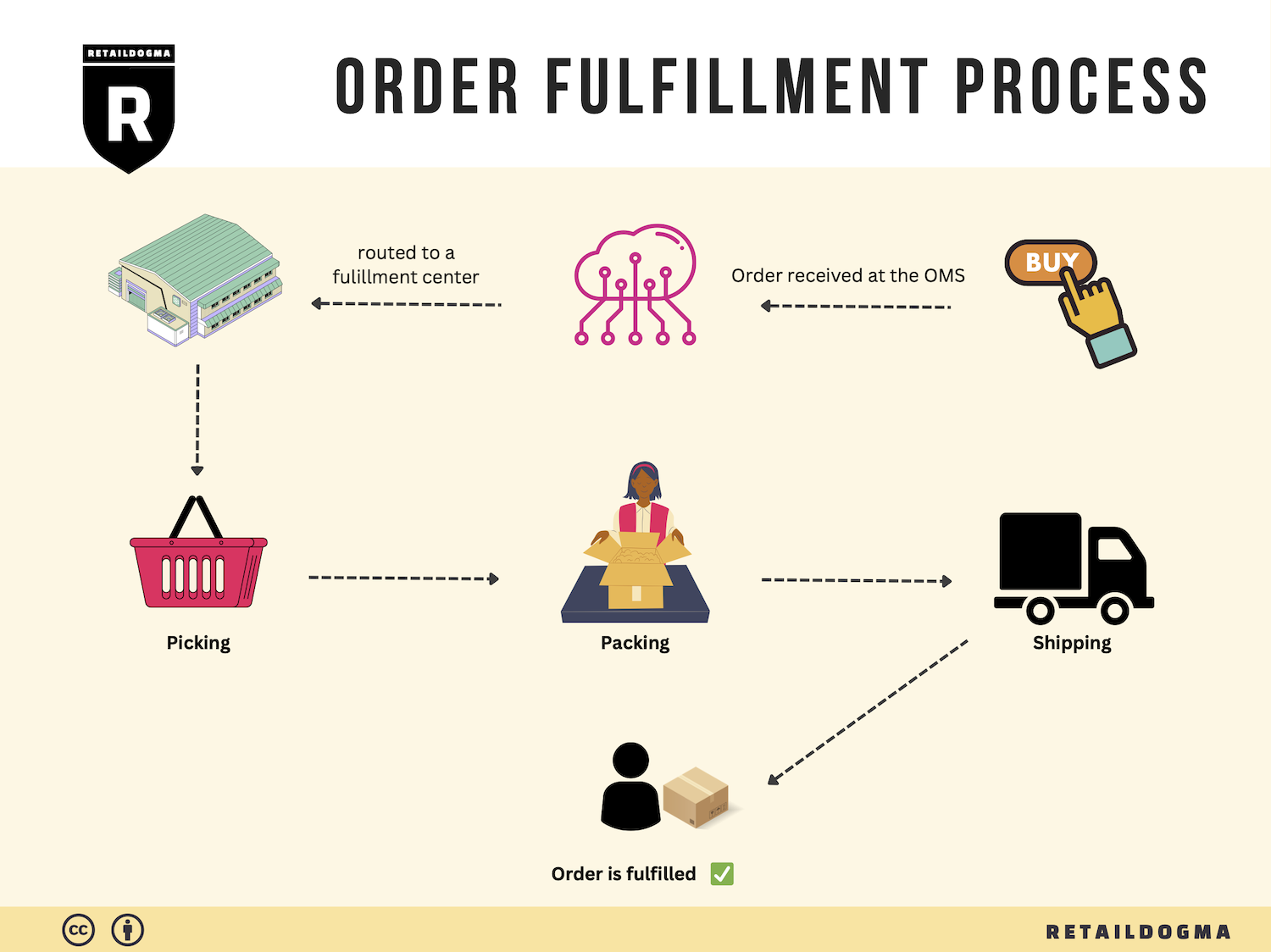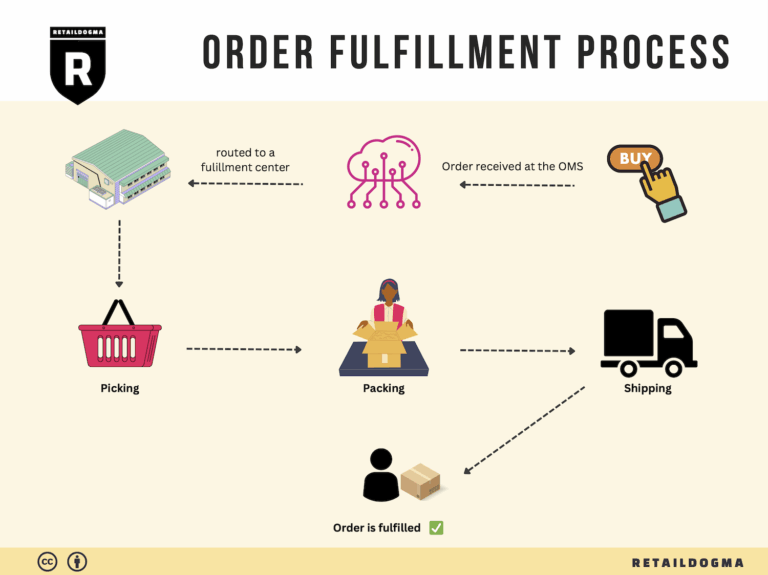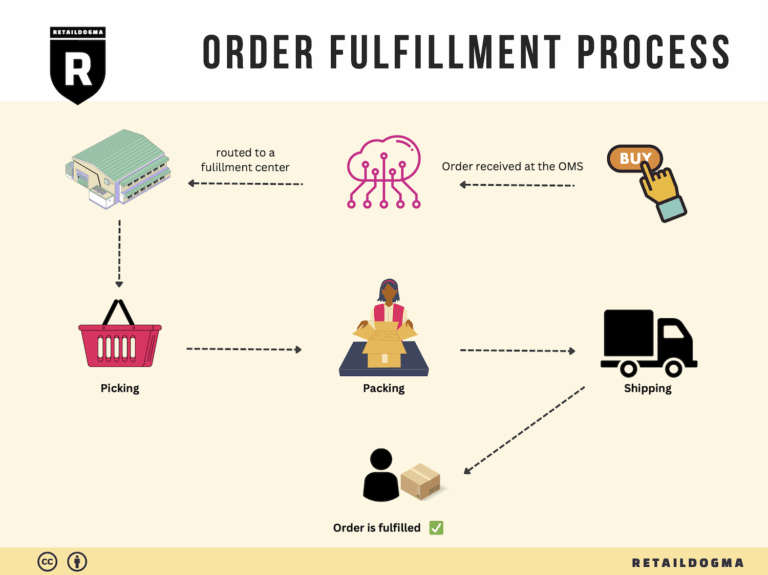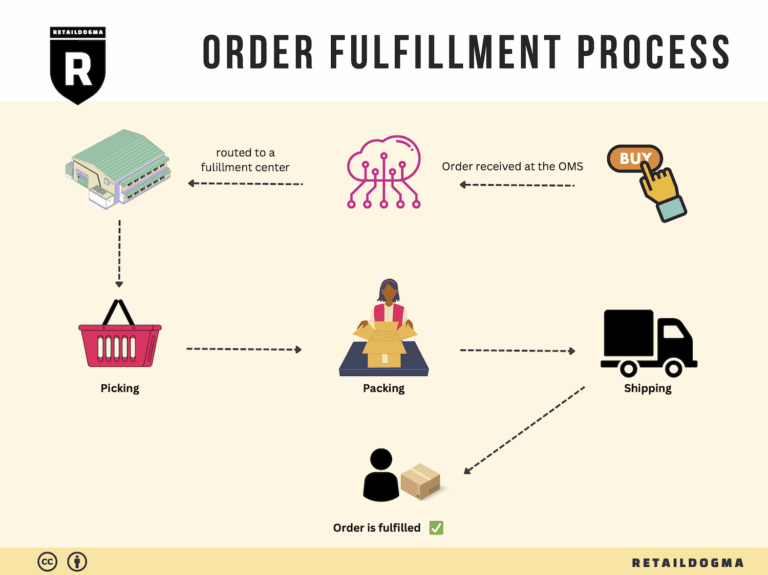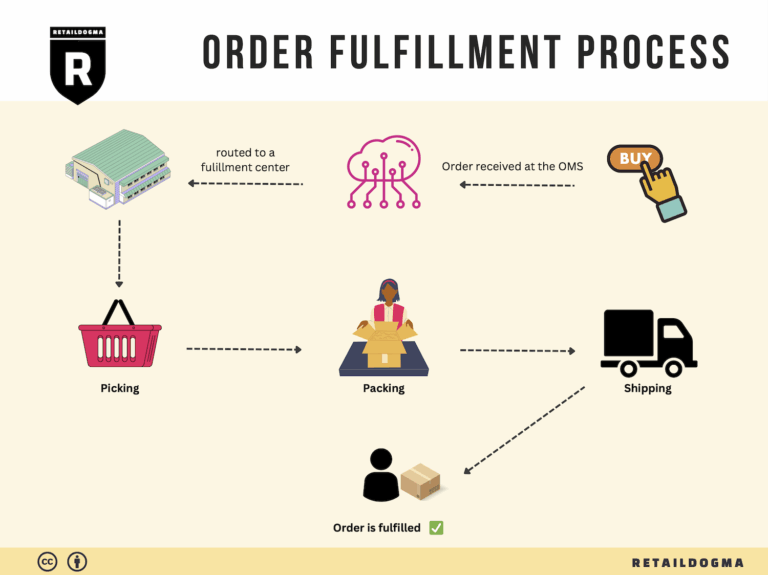Ecommerce Fulfillment Services: The Ultimate Guide (2025)
What is E-commerce Fulfillment? An Introduction for Growing Businesses
Understanding E-commerce Fulfillment: A Vital Component for Growth
As an e-commerce business owner, you may find yourself grappling with the complexities of packing and shipping orders. This overwhelming aspect of your operations can quickly consume valuable time and resources, ultimately hindering your ability to scale. Fulfillment, in its simplest form, refers to the process of getting a product into the hands of your customer. It encompasses everything from receiving inventory and processing orders to shipping and handling returns.
In today’s competitive online marketplace, efficient fulfillment is not just an operational necessity but a critical factor in customer satisfaction and retention. This guide aims to demystify e-commerce fulfillment and provide actionable insights for growing businesses.
Key Topics Covered in This Guide
-
Different Fulfillment Models: We’ll explore the various fulfillment models available, including traditional warehousing, third-party logistics (3PL), and Fulfillment by Amazon (FBA). Each model has its unique advantages and may suit different business needs, depending on your scale and operational capabilities.
-
Core Fulfillment Services: Understanding the essential services involved in fulfillment is crucial. We will break down the core services, such as inventory management, order processing, packing, shipping, and returns management, highlighting how these elements work together to create a seamless customer experience.
-
Choosing the Right Fulfillment Partner: Selecting a fulfillment partner can be daunting. This guide will outline the criteria to consider, including location, technology capabilities, scalability, and customer service. Making an informed choice can significantly impact your operational efficiency and customer satisfaction.
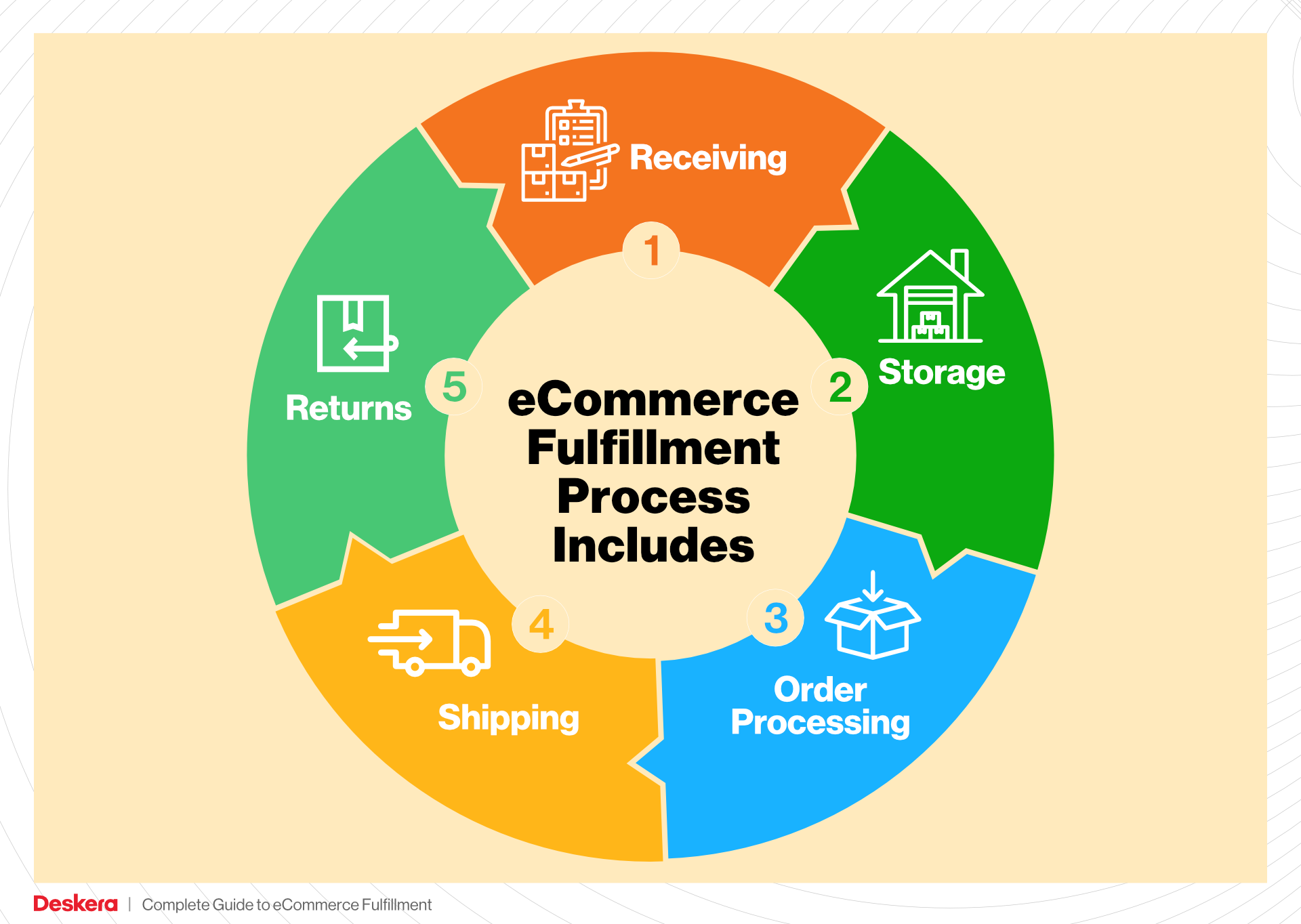
-
Pricing Structures: We’ll provide a clear overview of the pricing models associated with different fulfillment options. Understanding these costs is vital for budgeting and ensuring that your fulfillment strategy aligns with your financial goals.
Empowering Your Logistics Decisions
The ultimate goal of this guide is to empower you to make informed decisions about your logistics. By understanding the intricacies of e-commerce fulfillment, you can streamline your operations, reduce overhead, and enhance your customer experience. This foundational knowledge will allow you to focus on what you do best—growing your business—while leaving the complexities of fulfillment to the experts.
What You’ll Learn In This Guide
- What is E-commerce Fulfillment? An Introduction for Growing Businesses
- The Order Fulfillment Process: From ‘Buy’ Button to Customer’s Door
- Comparing Fulfillment Models: In-House vs. 3PL vs. Dropshipping
- A Deep Dive into Amazon FBA: Pros, Cons, and Who It’s For
- Core Services Offered by Fulfillment Centers
- How to Choose a Fulfillment Partner: A 6-Point Checklist
- Understanding Fulfillment Pricing: A Breakdown of Common Fees
- Frequently Asked Questions (FAQs) about Fulfillment
- Conclusion: Is Outsourcing Fulfillment the Right Move for Your Business?
- Important Disclaimer
The Order Fulfillment Process: From ‘Buy’ Button to Customer’s Door
1. Receiving Inventory
The order fulfillment process begins with receiving inventory at the fulfillment center. This step involves the physical arrival of products from suppliers or manufacturers, which are then checked for quality and quantity against purchase orders. Each item is assigned a Stock Keeping Unit (SKU), a unique identifier that helps track products throughout the supply chain.
Importance: Proper receiving procedures are critical as they lay the foundation for effective inventory management. Mistakes during this phase can lead to stock discrepancies, which may affect order accuracy and customer satisfaction. Ensuring that all products are received in good condition and accurately recorded helps maintain operational efficiency.
Key Term: SKU (Stock Keeping Unit) – A unique identifier assigned to each product for tracking purposes.
2. Warehouse Storage
Once inventory has been received and verified, the next step is warehouse storage. This involves organizing products within the fulfillment center in a manner that maximizes space and facilitates easy access. Efficient storage solutions, such as shelving, bins, and pallets, are utilized based on the type and size of the products.
Importance: Effective warehouse storage is vital for minimizing retrieval times and optimizing space utilization. A well-organized warehouse reduces the likelihood of inventory loss and improves overall operational efficiency. This step is also essential for preparing for the next phase of order fulfillment.
Key Term: FIFO (First In, First Out) – An inventory management strategy that ensures older stock is sold before newer stock, helping to reduce waste and obsolescence.
3. Order Picking
Order picking is the process of selecting items from the warehouse to fulfill customer orders. This is often guided by a pick list—a document that outlines the items needed for each order, including their locations within the warehouse. Workers use various methods for picking, such as batch picking (grouping orders) or zone picking (dividing the warehouse into sections).
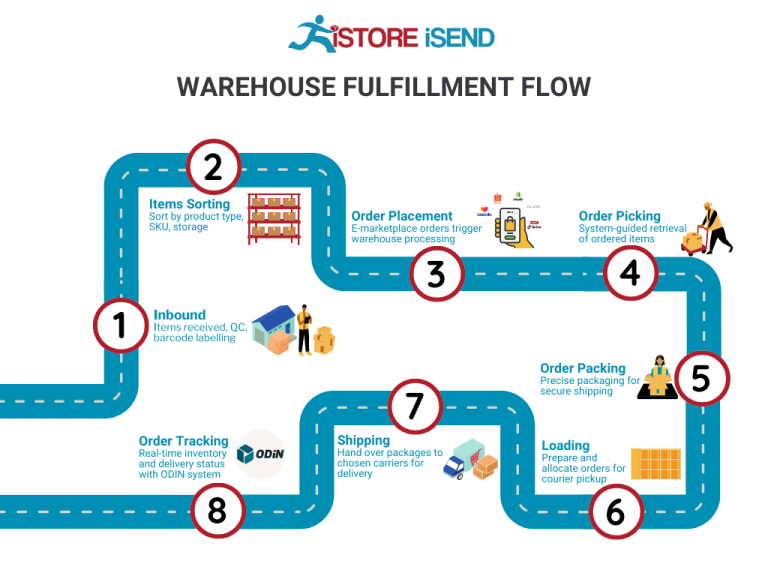
Importance: The efficiency and accuracy of order picking directly impact customer satisfaction. Errors during this phase can lead to incorrect shipments, which can result in costly returns and damage to brand reputation. Streamlining the picking process through technology, such as barcode scanners or automated systems, can enhance accuracy and speed.
Key Term: Pick List – A document or digital tool used to guide warehouse staff in selecting items for customer orders.
4. Order Packing
After items have been picked, the next step is order packing. During this phase, products are carefully packed into boxes or containers, ensuring they are secured for transportation. Packaging materials, such as bubble wrap or packing peanuts, are often used to protect items during shipping. Additionally, packing slips that detail the contents of each order are included.
Importance: Proper packing is crucial for preventing damage during transit and ensuring that customers receive their orders in perfect condition. Efficient packing processes can also help reduce shipping costs by optimizing package size and weight. This step is an opportunity to enhance the unboxing experience, which can positively impact customer perception.
Key Term: Packing Slip – A document included in the package that lists the items contained within, helping customers verify their order upon receipt.
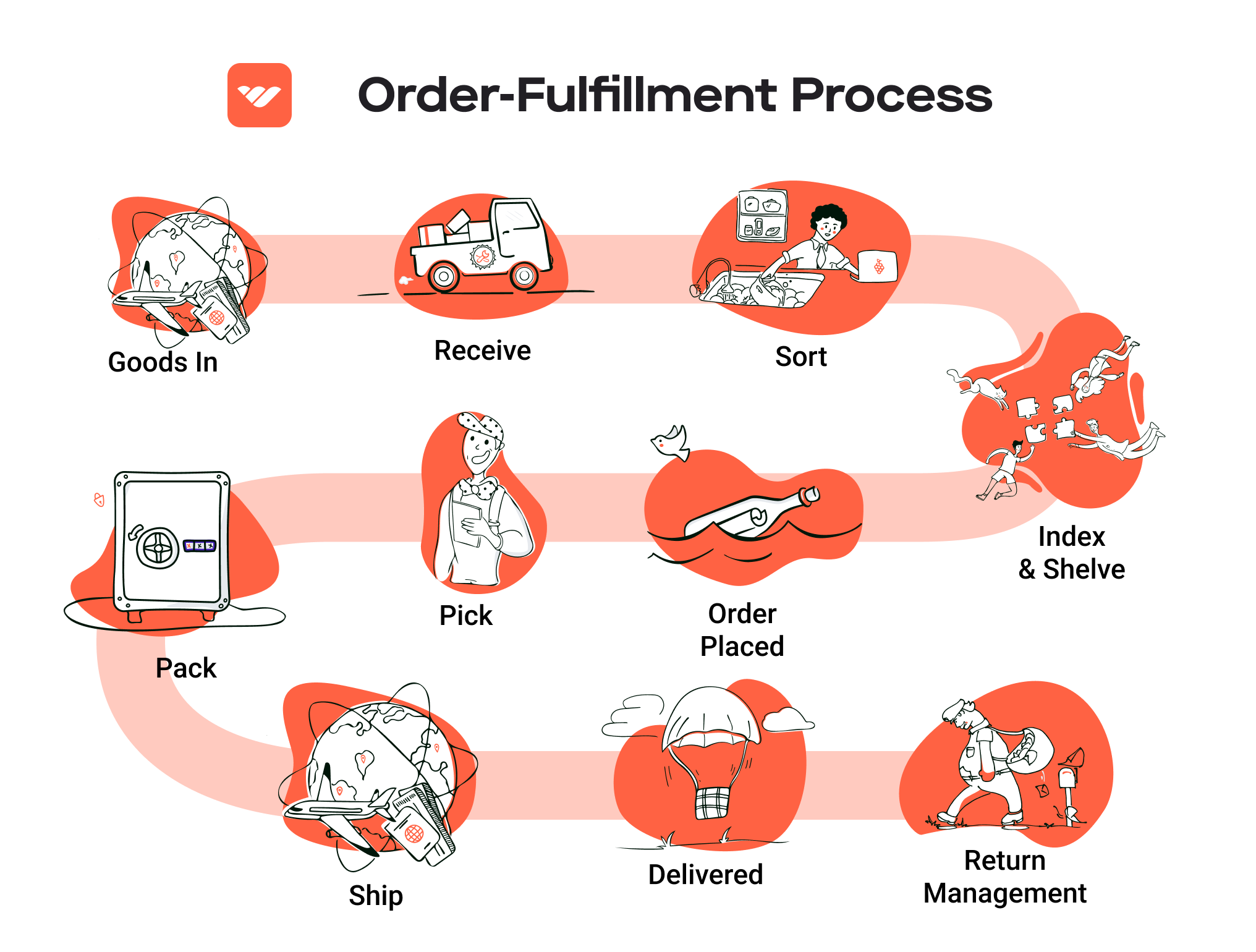
5. Shipping & Delivery
The final step in the order fulfillment process is shipping and delivery. Once orders are packed, they are labeled and prepared for shipment via various carriers (e.g., UPS, FedEx, or USPS). Tracking information is generated and shared with customers to keep them informed about the status of their deliveries.
Importance: Timely shipping and delivery are critical components of customer satisfaction. Efficient logistics ensure that products reach customers quickly and in good condition, fostering repeat business. Additionally, effective communication regarding shipping status can enhance the customer experience and build trust in the brand.
Key Term: Last Mile Delivery – The final step in the shipping process, where the package is delivered from a transportation hub to the customer’s door, often considered the most challenging and costly part of the logistics network.
By understanding and optimizing each of these five steps in the order fulfillment process, e-commerce businesses can enhance their operational efficiency, reduce costs, and ultimately improve customer satisfaction. This comprehensive approach not only streamlines logistics but also positions businesses for scalable growth in a competitive marketplace.
Comparing Fulfillment Models: In-House vs. 3PL vs. Dropshipping
Fulfillment Model Comparison
| Model | Who Handles Inventory | Best For (Business Stage) | Key Advantage | Key Disadvantage |
|---|---|---|---|---|
| In-House Fulfillment | The business itself | Established businesses scaling up | Complete control over inventory and process | High overhead costs and resource commitment |
| Third-Party Logistics (3PL) | An external logistics provider | Growing businesses looking to outsource | Access to expertise, technology, and scalability | Less control over inventory and processes |
| Dropshipping | Supplier | Startups and small businesses | Low upfront investment and risk | Lower profit margins and potential quality issues |
In-House Fulfillment
In-house fulfillment involves managing the entire logistics process within your own facilities. This model is most suitable for established businesses that are scaling up and require more control over their inventory and fulfillment processes. By handling inventory in-house, companies can ensure quality control, customize packaging, and have direct oversight of order processing. This can be a significant advantage when it comes to maintaining brand standards and customer satisfaction. However, in-house fulfillment comes with its challenges, including high overhead costs associated with warehousing, staffing, and technology. Additionally, as order volumes grow, businesses may find it increasingly difficult to manage logistics efficiently without investing heavily in additional resources. This model requires careful consideration of operational capabilities and financial implications before committing.
Third-Party Logistics (3PL)
Third-party logistics (3PL) providers manage logistics functions on behalf of businesses. This model is particularly beneficial for growing companies that want to outsource their warehousing and fulfillment operations to focus on core business activities such as marketing and sales. 3PL providers offer access to advanced technology, industry expertise, and scalable services that can adapt to fluctuating demand. They typically handle everything from inventory storage to order fulfillment, shipping, and returns, allowing businesses to benefit from economies of scale. However, the trade-off is that companies relinquish some control over their inventory and fulfillment processes, which can lead to inconsistencies in service quality or issues with inventory accuracy. Choosing the right 3PL partner is crucial; businesses must conduct thorough due diligence to ensure alignment with their operational standards and customer expectations.
Dropshipping
Dropshipping is a fulfillment model where the retailer does not keep products in stock but instead transfers customer orders and shipment details to a supplier, who then ships the products directly to the customer. This model is particularly appealing for startups and small businesses with limited capital, as it requires little to no upfront investment in inventory. The primary advantage of dropshipping is the reduced risk associated with unsold inventory and the ability to offer a wide range of products without the need for warehousing. However, dropshipping also presents challenges such as lower profit margins, as suppliers typically charge higher prices for their services. Additionally, businesses may face quality control issues since they rely on third-party suppliers for product quality and shipping speed, which can affect customer satisfaction. As a result, while dropshipping offers a low-risk entry point into e-commerce, it requires careful supplier selection and management to ensure a positive customer experience.
In conclusion, the choice of fulfillment model hinges on various factors, including business size, growth stage, operational capabilities, and financial resources. Each model presents unique advantages and disadvantages that should align with your overall business strategy and customer service goals. By understanding these differences, e-commerce business owners and operations managers can make informed decisions that facilitate scalability and enhance customer satisfaction.
A Deep Dive into Amazon FBA: Pros, Cons, and Who It’s For
Understanding Fulfillment by Amazon (FBA)
Fulfillment by Amazon (FBA) is a service provided by Amazon that allows e-commerce sellers to store their products in Amazon’s fulfillment centers. Amazon takes care of storage, packaging, shipping, and even customer service for these products. This service enables sellers to leverage Amazon’s vast logistics network and customer base, providing an opportunity to scale their businesses efficiently.
When a customer orders a product, Amazon handles the entire process from picking the item from the warehouse to shipping it directly to the customer. This service is particularly appealing for small to medium-sized businesses that may not have the resources or infrastructure to manage their own logistics.
How FBA Works
-
Setting Up an FBA Account: Sellers must first create an Amazon Seller account and then enroll in the FBA program. This involves providing necessary business information and agreeing to the FBA terms.
-
Preparing Products: Sellers need to prepare their products according to Amazon’s guidelines. This includes labeling and packaging items correctly to ensure they can be efficiently processed in the fulfillment centers.
-
Shipping to Amazon: Once the products are prepared, sellers ship their inventory to Amazon’s fulfillment centers. Amazon provides specific shipping plans and guidelines to streamline this process.
-
Storage and Management: Products are stored in Amazon’s warehouses. Sellers can monitor their inventory levels through the Amazon Seller Central dashboard, which provides insights into stock levels and sales performance.
-
Order Fulfillment: When a customer makes a purchase, Amazon picks, packs, and ships the product. The seller is notified of the sale and can track the order’s progress.
-
Customer Service and Returns: Amazon also manages customer service inquiries and handles returns on behalf of the seller, allowing sellers to focus on other aspects of their business.
Pros of Fulfillment by Amazon (FBA)
1. Prime Eligibility
FBA products automatically become eligible for Amazon Prime, which is a significant advantage. Prime members are more likely to purchase items that offer free two-day shipping, resulting in higher sales potential for FBA sellers.
2. Trust and Credibility
Amazon is a well-established brand known for its customer service. By using FBA, sellers can benefit from Amazon’s reputation, which can enhance customer trust. This is particularly important for new sellers looking to establish themselves in a competitive marketplace.
3. Multi-Channel Fulfillment
FBA can serve as a multi-channel fulfillment solution. Sellers can use FBA to fulfill orders from their own websites or other sales channels. This flexibility allows businesses to centralize their logistics, simplifying inventory management and shipping processes.
4. Streamlined Operations
FBA allows sellers to outsource the logistics aspect of their business, enabling them to focus on product development, marketing, and customer engagement. This can lead to increased efficiency and potentially higher profit margins.
5. Access to Advanced Tools
Amazon provides FBA sellers with access to various tools and analytics that can help optimize their inventory management, sales performance, and marketing strategies. These insights can be invaluable for scaling a business.
Cons of Fulfillment by Amazon (FBA)
1. High Fees
While FBA provides many benefits, it also comes with associated costs. Sellers must pay for storage fees, fulfillment fees, and other charges that can add up quickly. For low-margin products, these fees can significantly cut into profits.
2. Strict Inventory Management Rules
Amazon has stringent policies regarding inventory management. Sellers must adhere to guidelines for product preparation, labeling, and storage. Failure to comply can result in additional fees or restrictions on selling.
3. Commingling Risks
FBA employs a commingling policy, where products from different sellers are stored together. This can create risks if a seller’s inventory is mixed with defective or damaged items from other sellers, potentially leading to negative customer experiences and returns.
4. Limited Control Over Branding
When using FBA, sellers have limited control over how their products are packaged and presented. This can be a drawback for brands that prioritize unique branding experiences and customer interaction.
5. Dependency on Amazon’s Policies
Sellers are subject to Amazon’s changing policies, which can affect their business operations. This dependency means that a seller’s success can be significantly influenced by decisions made by Amazon.
Who is FBA Best For?
Fulfillment by Amazon is ideally suited for:
-
Small to Medium-Sized Businesses: Companies that lack the infrastructure to handle their own logistics can benefit from FBA’s comprehensive service, allowing them to compete with larger retailers without significant capital investment.
-
E-commerce Entrepreneurs: New entrepreneurs looking to establish themselves in the market can leverage Amazon’s platform and customer base to gain traction quickly.
-
Sellers with High Sales Volume: Businesses that anticipate high sales volumes can benefit from the economies of scale provided by FBA, potentially leading to lower fulfillment costs per unit.
-
Brands Seeking Prime Customers: Sellers aiming to reach Amazon’s vast Prime customer base will find FBA essential for maximizing their sales potential.
In conclusion, FBA offers a robust solution for e-commerce businesses looking to streamline their logistics and enhance their market presence. However, it is crucial for sellers to weigh the pros and cons carefully, ensuring that they align with their business goals and operational capabilities.
Core Services Offered by Fulfillment Centers
Inventory Management & Warehousing
Fulfillment centers like Amazon BFI1 provide comprehensive inventory management and warehousing services that are crucial for e-commerce businesses aiming to scale. This service involves the systematic storage of goods, ensuring that products are readily available to meet customer demand without overstocking.
What It Is:
Inventory management encompasses tracking stock levels, orders, sales, and deliveries. Advanced inventory systems allow fulfillment centers to monitor real-time data, which enables businesses to make informed decisions about restocking and product availability. Warehousing services ensure that products are stored in a secure and organized environment, often utilizing sophisticated technology for optimal space utilization.
Benefits:
1. Efficiency in Stock Management: By outsourcing inventory management to a fulfillment center, e-commerce businesses can reduce the burden of tracking inventory manually. This efficiency minimizes errors and ensures that stock levels are optimized.
-
Scalability: As your business grows, the ability to manage larger volumes of inventory without investing in additional warehouse space becomes essential. Fulfillment centers provide the flexibility to scale operations up or down based on demand.
-
Cost Savings: Businesses can save on overhead costs associated with maintaining their own warehouses, including rent, utilities, and staffing. Fulfillment centers often leverage economies of scale, which can translate into lower costs for their clients.
Pick and Pack Services
Pick and pack services are fundamental to the fulfillment process, ensuring that products are efficiently selected from inventory and prepared for shipment to customers.
What It Is:
This service involves the picking of items from the warehouse based on customer orders and packing them securely for delivery. Fulfillment centers employ trained staff and automated systems to streamline this process, ensuring accuracy and speed.
Benefits:
1. Improved Order Accuracy: With trained professionals and advanced technology in place, fulfillment centers significantly reduce the likelihood of picking errors, which can lead to customer dissatisfaction and costly returns.
-
Faster Order Fulfillment: Efficient pick and pack processes allow for quick turnaround times on orders. This speed is critical for maintaining customer satisfaction, particularly for businesses that offer same-day or next-day delivery options.
-
Focus on Core Business Functions: By outsourcing pick and pack services, e-commerce businesses can concentrate on marketing, product development, and customer service rather than logistics, enabling them to grow their brand more effectively.
Kitting and Assembly
Kitting and assembly services offered by fulfillment centers enable businesses to combine multiple products into one cohesive unit, enhancing the customer experience and streamlining shipping processes.
What It Is:
Kitting refers to the process of gathering various items and packaging them together as a single product. Assembly may involve putting together components to create a finished product. Fulfillment centers often have the capability to manage these processes efficiently, ensuring that items are assembled correctly and packaged attractively.
Benefits:
1. Enhanced Product Offering: Kitting allows businesses to create bundled products that can be marketed as value deals, appealing to consumers looking for convenience and savings.
-
Streamlined Shipping: By shipping products as a kit, businesses can reduce the number of individual packages sent out, leading to lower shipping costs and simplified logistics.
-
Customization Options: Fulfillment centers can offer customized kitting solutions, allowing businesses to cater to specific customer needs or preferences, thereby enhancing customer satisfaction and loyalty.
Returns Management (Reverse Logistics)
Returns management is a vital service provided by fulfillment centers, addressing the complexities of handling product returns and exchanges in a streamlined manner.
What It Is:
Returns management, or reverse logistics, involves processing returned items, assessing their condition, restocking them if possible, and managing exchanges or refunds. Fulfillment centers are equipped to handle these processes efficiently, ensuring that returns do not disrupt overall operations.
Benefits:
1. Customer Satisfaction: A well-managed returns process enhances customer trust and satisfaction. Quick and hassle-free returns encourage repeat business, as customers feel more secure in their purchases.
-
Cost Efficiency: By efficiently managing returns, fulfillment centers can minimize losses associated with unsold inventory and reduce the time spent on processing returns.
-
Data Insights: Returns management provides valuable insights into customer preferences and product performance. This data can inform product development, inventory management, and marketing strategies, enabling businesses to make data-driven decisions.
In conclusion, utilizing the core services offered by fulfillment centers, such as inventory management, pick and pack, kitting and assembly, and returns management, can significantly enhance the operational efficiency of e-commerce businesses. By leveraging these services, entrepreneurs and operations managers can focus on scaling their sales while ensuring customer satisfaction and loyalty.
How to Choose a Fulfillment Partner: A 6-Point Checklist
Location & Warehouse Network
Importance: The location of your fulfillment partner’s warehouses is critical for efficient distribution. Proximity to your customer base can significantly reduce shipping times and costs, enhancing customer satisfaction and loyalty.
Questions to Ask:
– Where are your warehouses located, and how many do you operate?
– How do you determine the locations of your fulfillment centers?
– Can you provide insights on shipping times to my target markets?
– What is your network’s capacity for handling peak seasons or unexpected demand spikes?
Technology & Integrations
Importance: In today’s e-commerce landscape, technology is a vital component of efficient logistics. A fulfillment partner that utilizes advanced technology can offer real-time tracking, inventory management, and seamless integration with your e-commerce platform.
Questions to Ask:
– What technology do you use to manage inventory and orders?
– How does your system integrate with popular e-commerce platforms (e.g., Shopify, Amazon)?
– Do you offer real-time tracking for shipments and inventory?
– Can you provide API access for more customized integrations?
Specializations (e.g., cold storage, oversized items)
Importance: Different products require different handling and storage solutions. If your business deals with specific types of goods—such as perishables, oversized items, or hazardous materials—it’s essential to choose a partner that specializes in those areas.
Questions to Ask:
– Do you have experience handling my specific product types?
– What special facilities do you offer (e.g., climate-controlled storage, specialized packaging)?
– Can you accommodate unique requirements such as kitting or custom labeling?
– What certifications do you hold for handling specialized products?
Scalability & Capacity
Importance: As your business grows, your fulfillment needs will evolve. A good fulfillment partner should be able to scale operations to meet your increasing demand without compromising service quality.
Questions to Ask:
– What is your current capacity for order fulfillment, and how do you plan to scale?
– How do you handle seasonal fluctuations in order volume?
– Can you accommodate rapid growth or unexpected spikes in demand?
– What systems do you have in place for scaling up operations quickly?
Pricing and Contracts
Importance: Understanding the pricing structure and contractual terms is essential to ensure that your fulfillment partner aligns with your budget and financial goals. Hidden fees and unfavorable terms can lead to unexpected costs.
Questions to Ask:
– What is your pricing model (e.g., per order, per item, monthly fees)?
– Are there any additional fees (e.g., storage, packaging, returns)?
– What are the terms of the contract, and is there flexibility for renegotiation?
– How do you handle pricing adjustments during peak seasons?
Customer Support & Reviews
Importance: Strong customer support is crucial for resolving issues quickly and maintaining a smooth operation. Additionally, reviews and testimonials can provide insights into a partner’s reliability and service quality.
Questions to Ask:
– What customer support options do you offer (e.g., phone, email, chat)?
– What are your average response times for customer inquiries?
– Can you provide references or case studies from current clients?
– How do you handle customer complaints or fulfillment issues?
Conclusion
Choosing the right fulfillment partner is a pivotal decision for any e-commerce business. By following this checklist, you can evaluate potential partners thoroughly and select one that aligns with your operational needs and growth ambitions. Remember, a well-chosen partner not only enhances your logistics capabilities but also contributes significantly to your overall customer satisfaction and business success.
Understanding Fulfillment Pricing: A Breakdown of Common Fees
Initial Setup Fees
When partnering with a fulfillment center, such as Amazon’s BFI1, businesses often encounter initial setup fees. These fees are generally charged to onboard your products into the fulfillment system. The setup process may include inventory registration, system integration, and the labeling of products to meet the fulfillment center’s requirements.
Calculation: Initial setup fees can vary significantly based on the complexity of your inventory and the fulfillment center’s policies. For instance, some centers may charge a flat fee for initial setup, while others might charge based on the number of SKUs (Stock Keeping Units) you are onboarding. Always ask for a breakdown of what the setup fee covers to avoid unexpected costs.
Receiving Fees
Receiving fees are charged when your inventory arrives at the fulfillment center. This fee covers the labor and equipment costs associated with unloading, inspecting, and storing your products. Efficient receiving processes are essential to minimize delays and ensure that inventory is available for shipping as quickly as possible.
Calculation: Receiving fees are typically charged per pallet or per unit received, depending on the fulfillment center’s pricing model. For example, a center may charge a flat rate for each pallet received or a variable rate based on the volume of items. It’s crucial to understand how these fees are structured, especially if you’re sending large shipments.
Storage Fees (per pallet/bin)
Storage fees are incurred for keeping your inventory in the fulfillment center. These fees can significantly impact your overall logistics costs, especially if your products have a long shelf life or if they are slow-moving items.
Calculation: Storage fees are usually calculated on a monthly basis and charged per pallet or per bin. The rate may vary based on the time of year, with higher rates during peak seasons like the holidays. Some fulfillment centers offer tiered pricing, where the cost per pallet decreases as the volume increases. Make sure to ask about any minimum storage commitments or penalties for exceeding storage limits.
Pick & Pack Fees (per item/order)
Pick and pack fees are charged for the labor involved in selecting items from inventory and packing them for shipment. This fee can be a significant part of your fulfillment costs, especially for businesses with diverse product lines or custom packaging needs.
Calculation: These fees are typically calculated per item picked or per order packed. Some fulfillment centers may also charge additional fees for special packaging requests or for handling returns. Understanding the pick and pack fee structure is vital for pricing your products correctly and managing your margins.
Shipping Fees
Shipping fees cover the costs associated with transporting your products from the fulfillment center to your customers. These fees can vary widely based on the shipping method chosen, the destination, and the weight and dimensions of the package.
Calculation: Shipping fees are generally based on the carrier’s rates, which can fluctuate based on factors such as shipping speed (standard, expedited, etc.), distance, and package size. Many fulfillment centers offer discounted shipping rates due to their volume, which can be beneficial for your business. It’s advisable to ask for a shipping fee estimate for various scenarios to understand how shipping costs will affect your overall fulfillment expenses.
Conclusion: Tips for Getting an Accurate Quote
To ensure you receive an accurate quote for fulfillment services, consider the following tips:
-
Provide Detailed Product Information: Share comprehensive details about your inventory, including dimensions, weight, and any specific handling requirements. This information helps fulfillment centers provide precise estimates.
-
Understand Your Volume Needs: Be clear about your expected shipping volumes, as many fees can be affected by the scale of your operations. Higher volumes may qualify for better rates.
-
Ask for a Fee Breakdown: Request a detailed breakdown of all potential fees, including any variable costs. This will help you understand the full scope of your fulfillment expenses.
-
Consider Seasonal Fluctuations: Inquire about how fees may change during peak seasons. Understanding these fluctuations will help you budget more effectively.
-
Negotiate Terms: Don’t hesitate to negotiate terms and fees, especially if you’re committing to a long-term partnership. Many fulfillment centers are willing to adjust pricing based on volume or contract length.
By keeping these factors in mind, e-commerce businesses can effectively manage their fulfillment costs and scale their operations efficiently.
Frequently Asked Questions (FAQs) about Fulfillment
1. What is the Amazon BFI1 fulfillment center?
Amazon BFI1, located in Sumner, Washington, is a key fulfillment center in Amazon’s logistics network. It specializes in storing, packing, and shipping a wide variety of products for e-commerce transactions. The facility is designed to handle high volumes of inventory efficiently, ensuring quick delivery to customers.
2. How does fulfillment by Amazon (FBA) work?
Fulfillment by Amazon (FBA) is a service where Amazon takes care of storage, packing, and shipping of products sold by third-party sellers. Sellers send their products to Amazon’s fulfillment centers, like BFI1, and Amazon handles the logistics, customer service, and returns, allowing sellers to focus on growing their businesses.
3. What is the difference between a warehouse and a fulfillment center?
A warehouse primarily serves as a storage facility for goods, focusing on inventory management and bulk storage. In contrast, a fulfillment center is specifically designed for the order fulfillment process, which includes picking, packing, and shipping products directly to customers. Fulfillment centers prioritize speed and efficiency to meet customer demand for quick delivery.
4. What are the advantages of using Amazon BFI1 for fulfillment?
Utilizing Amazon BFI1 offers several advantages, including:
- Speedy Shipping: Access to Amazon Prime services for faster delivery options.
- Scalability: Easily scale your inventory and fulfillment as your business grows.
- Cost Efficiency: Reduce overhead costs associated with logistics and warehousing.
- Customer Trust: Leverage Amazon’s established reputation for reliable service.
5. How much do fulfillment services cost?
The cost of fulfillment services can vary based on several factors, including the type of service, volume of orders, and storage needs. For FBA, sellers typically pay for storage fees based on the amount of space their products occupy and fulfillment fees based on the size and weight of the items sold. It’s essential to review Amazon’s fee structure for detailed pricing.
6. What is a 3PL, and how does it differ from FBA?
A Third-Party Logistics (3PL) provider offers logistics services such as warehousing, fulfillment, and transportation management to businesses. Unlike FBA, which is specifically tied to Amazon’s ecosystem, a 3PL can service multiple sales channels and may offer customized solutions based on individual business needs. This flexibility can be beneficial for sellers who operate outside of Amazon.
7. How does Amazon determine the location of its fulfillment centers?
Amazon strategically selects fulfillment center locations based on various factors such as proximity to customer populations, transportation infrastructure, workforce availability, real estate costs, and market demand. This ensures efficient logistics and faster shipping times to meet customer expectations.
8. Can I track my inventory stored at BFI1?
Yes, Amazon provides sellers with tools to track their inventory stored at fulfillment centers like BFI1. Sellers can use the Amazon Seller Central dashboard to monitor stock levels, sales, and fulfillment performance, allowing for effective inventory management.
9. What types of products can be fulfilled through BFI1?
Amazon BFI1 can handle a wide range of products, including consumer electronics, household items, clothing, and more. However, there are restrictions on certain categories, such as hazardous materials and perishable goods. Sellers should consult Amazon’s guidelines to ensure their products meet fulfillment requirements.
10. How can I get started with using Amazon BFI1 for my business?
To start using Amazon BFI1 for fulfillment, sign up for an Amazon Seller account and enroll in the FBA program. After that, prepare your products according to Amazon’s packaging and labeling requirements, and ship them to the BFI1 fulfillment center. From there, Amazon will handle the rest, including storage, packing, and shipping to customers.
Conclusion: Is Outsourcing Fulfillment the Right Move for Your Business?
Evaluating the Benefits of Outsourcing Fulfillment
Outsourcing your fulfillment can be a game-changer for your e-commerce business, enabling you to focus on core activities such as product development and marketing while streamlining logistics. One of the most significant advantages is the time savings. By partnering with a fulfillment service, you can eliminate the complexities of warehousing, inventory management, and shipping logistics, allowing you to redirect your resources towards growth strategies.
Scalability is another critical benefit. As your business expands, so do your fulfillment needs. Outsourcing provides the flexibility to scale operations without the burden of investing in additional infrastructure or workforce. This adaptability is crucial in a dynamic market where demand can fluctuate rapidly. A reliable fulfillment partner can accommodate seasonal spikes in orders or unexpected growth, ensuring your operations remain seamless.
Moreover, leveraging the expertise of a fulfillment service, like those offered by Amazon’s BFI1 facility, can significantly enhance your operational efficiency. These partners are equipped with advanced technology and industry knowledge, allowing for optimized inventory management, faster shipping times, and improved customer satisfaction.
However, the choice of a fulfillment partner is paramount. It’s essential to select a provider that aligns with your business goals, offers transparent communication, and has a proven track record of reliability.
Take Action: Assess Your Current Shipping Process
To determine if outsourcing fulfillment is the right step for your business, start with a comprehensive audit of your current shipping process. Analyze your costs, delivery times, and customer feedback. This evaluation will provide insights into whether a fulfillment partner could enhance your operational efficiency and customer satisfaction. Transitioning to a fulfillment service can be a strategic move that propels your business toward sustainable growth and success.
Important Disclaimer
⚠️ Important Disclaimer
The information in this guide is for educational purposes. Fulfillment services, pricing, and platform features change frequently. Always conduct your own due diligence and consult with providers directly before making business decisions.
